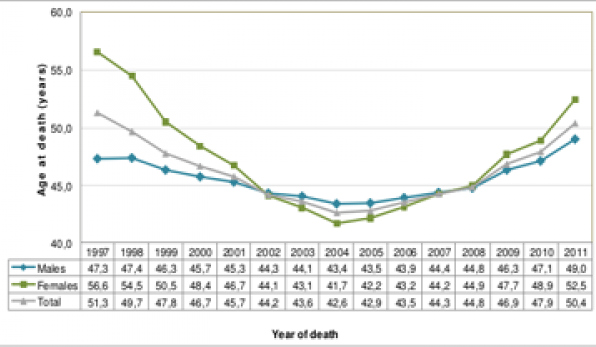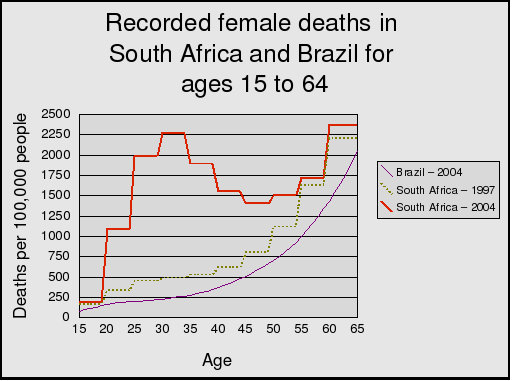
Stats SA graph shows median age of death dropping from 1997 to 2004 then rising again. (See page 21 of this report.)
14 March 2016
Former president Mbeki published an article this morning disputing that there is a large HIV epidemic. This note explains how we know that the HIV epidemic has for many years been the largest cause of death in South Africa.
1. In 2001, leading epidemiologists analysed death data in detail. Their report was published by the South African Medical Research Council. They wrote that it was “highly probable that about 40% of the adult South African 1999/00 mortality in the 15-49 age group is due to HIV/AIDS.”
2. The graph below shows the ages at which most women between the ages of 15 and 64 died in Brazil in 2004, and South Africa in 1997 and 2004. Normally, fewer people die at younger ages as we see in the curve showing Brazilian deaths, and the 1997 South African deaths. If you construct similar graphs for Sweden, the US, Argentina, China or just about any country without a large HIV epidemic, you will see the same shape.
But in 2004 in South Africa, most of the recorded adult deaths are in people aged 25 to 40. Only the HIV epidemic can explain this change.

3. Mbeki makes much of the fact that if you look at the recorded cause of death indicated on death certificates, HIV is often quite far down the list. There are several good reasons for this. Here are two: (1) People often die of AIDS-related illnesses without being diagnosed with HIV. (2) The doctor filling in a death certificate might, either out of sensibility for the patient’s family due to the stigma of AIDS or because he or she isn’t aware of the patient’s status, indicate the disease that is the immediate rather than underlying cause of death, such as TB or pneumonia.
Presumably aware of this problem, Stats SA analysed the death certificates from 1997 to 2001 closely to calculate the causes of death more precisely. There are too many death records to consider all, so they took a 12% random sample. Their report shows a rise in HIV deaths over time and by 1999 HIV was the leading cause of death in women.
4. But even without this report you can see on close inspection of other Stats SA mortality reports that HIV is the biggest cause of death - by far. Consistently through the 2000s, the top three recorded causes of death are TB, influenza and pneumonia, and intestinal infectious diseases. They all rise dramatically over time, declining again with the scale up of antiretroviral treatment. What do all three have in common? They are frequently the diseases that kill people with HIV. Only the HIV epidemic can explain their massive rises in the 2000s. For example, recorded TB deaths rose from less than 26,000 in 1997 to over 77,000 in 2006. It is true that death registration improved, but not enough to explain this.
5. As the Stats SA graph in the top image of this article shows, the median age of death in 1997 was 51. This dropped to 43 by 2004 and then began increasing slowly again. In 2011, it exceeded 50 for the first time since 1997. (See here for further details.) The decline corresponds to the rise of the HIV epidemic, while the increase corresponds to the scale up of antiretroviral treatment.
This is just a small bit of the evidence of the enormous mortality due to AIDS in South Africa. There is much more.
The above is a much simplified account. The study of epidemiology is complex, requiring many years of study followed by careful research before scientists publish their findings in reputable peer-reviewed journals. It is strange that the former president believes he has the skills or knowledge to dispute this work despite having no qualifications in this field.
See also South Africans living longer but drug-resistant TB remains a threat.